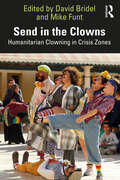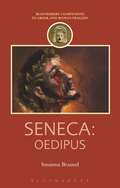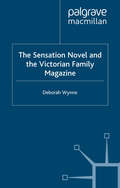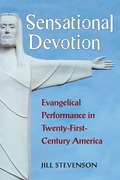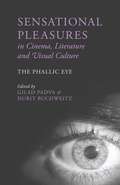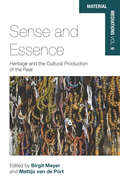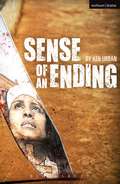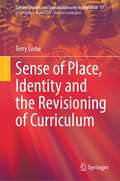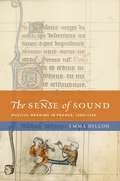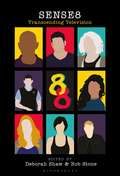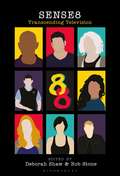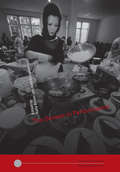- Table View
- List View
Send in the Clowns: Humanitarian Clowning in Crisis Zones
by David Bridel Mike FuntSend in the Clowns presents interviews with twenty-four pioneering humanitarian and activist clowns and thought leaders working in hospitals, refugee camps, orphanages and war zones, and at the sites of street protests and locations of social unrest across the world.This book is built around interviews with some of the world’s leading practitioners of clowning for change, justice, and health outside of the entertainment mainstream, featuring artists and organizations including Patch Adams (US), the Dream Doctors Project (Israel), Clown Me In (Lebanon), and Doutores da Alegria (Brazil). Situating the topic in relation to indigenous and ritual clowning, investigating the various functions of the clown in early societies, and centering the discourse around interviews with key practitioners, the book explores a wide range of clown applications across the globe. This includes the special significance of the clown archetype in socially, politically, and culturally challenging situations, the successes and challenges of the art activists who are at the forefront of this movement, and the modern humanitarian clown’s relationship to original forms of clowning that can be traced back through history.This is a vital resource for anyone studying, teaching, or practicing clown work in applied contexts, from health care to conflict resolution.
Seneca: Oedipus (Companions to Greek and Roman Tragedy)
by Susanna BraundOedipus, king of Thebes, is one of the giant figures of ancient mythology. Through the centuries, his story has inspired works of epic poetry, lyric poetry, tragedy, opera, a gospel musical and more. Famous today thanks to Sigmund Freud's famous phrase 'the Oedipus complex', the most famous version of the Oedipus myth from antiquity is the Greek play by Sophocles. But there is another version, the Latin drama by the Roman philosopher and politician Seneca.Seneca's play reflects concerns special to the author and his Roman audience. Moreover, it exercised a much greater influence on European literature and thought than has usually been suspected. This book offers a compact and incisive study of the multi-faceted Oedipus myth, of Seneca as dramatist, of the play's distinctive characteristics and of the most important aspects of the reception of the play in European drama and culture to the current day. No knowledge of Latin or other foreign languages is required.
Seneca: Oedipus (Companions to Greek and Roman Tragedy)
by Susanna BraundOedipus, king of Thebes, is one of the giant figures of ancient mythology. Through the centuries, his story has inspired works of epic poetry, lyric poetry, tragedy, opera, a gospel musical and more. The myth has been famously deployed in psychology by Sigmund Freud. It may not be too bold to claim that Oedipus is the name from Greco-Roman mythology best known beyond the academy at the present time, thanks to Freud's famous phrase 'the Oedipus complex'. The most famous version of the Oedipus myth from antiquity is the Greek play by Sophocles. But there is another version, the Latin drama by the Roman philosopher and politician Seneca.Seneca's version is an entirely different treatment from that of Sophocles and reflects concerns special to the author and his Roman audience in the first century AD. Moreover, the play actually exercised a much greater influence on European literature and thought than has usually been suspected. This book offers a compact and incisive study of the multi-faceted Oedipus myth, of Seneca as dramatist, of the distinctive characteristics of Seneca's play and of the most important aspects of the reception of the play in European drama and culture. The scope of the book ranges chronologically from Homer's treatment of Oedipus myth in the Odyssey down to a twenty-first century Senecan treatment by a Lebanese Canadian dramatist. No knowledge of Latin or other foreign languages is required.
Senefelder on Lithography: The Classic 1819 Treatise
by Alois SenefelderThe invention in the late eighteenth century of lithography, or "writing on stone," reshaped the course of graphic arts. Some years later, the father of this world-changing technology, Alois Senefelder, published a description of the process. This English translation of the original German work, Vollständiges Lehrbuch der Steindruckerey, vividly describes Senefelder's struggles to develop and popularize the medium and the lithographic techniques employed in the process. The work is divided into two parts: the first presents a history of the invention and its different processes; the second provides practical instructions for its application--the varieties of stone, ink, instruments, paper, and presses used for different tasks, and the pitfalls to be avoided in working with these materials. An essential reference for graphic artists and students, the classic 1819 treatise remains the definitive work on this topic.
The Sensation Novel and the Victorian Family Magazine
by D. WynneVictorian sensation novels, with their compulsive plots of crime, transgression and mystery, were bestsellers. Deborah Wynne analyses the fascinating relationships between sensation novels and the magazines in which they were serialized. Drawing upon the work of Wilkie Collins, Mary Braddon, Charles Dickens, Ellen Wood, and Charles Reade, and such popular family journals as All The Year Round, The Cornhill, and Once a Week , the author highlights how novels and magazines worked together to engage in the major cultural and social debates of the period.
Sensational Devotion: Evangelical Performance in Twenty-First-Century America
by Jill C StevensonSensational Devotion examines contemporary Passion plays, biblical theme parks, Holy Land recreations, creationist museums, and megachurches in order to understand how they serve their evangelical believer-users while also shaping larger cultural and national dialogues. Jill Stevenson explores how performative media support specific theologies and core beliefs by creating sensual, live experiences for those who use them. The book explores evangelical performance across a range of media and sites, including film, television, theater, tourist attractions, museums, and places of worship. Using historical research coupled with firsthand experiences, it critically examines these spaces and events within their specific religious, cultural, and national contexts, while placing them within a long devotional tradition to suggest how they cultivate religious belief by generating vivid, sensual, affectively oriented, and individualized experiences. Stevenson’s analysis builds upon existing work on performance and cognition, as well as theories of affect, as it contributes to existing scholarship on American evangelicalism and evangelical Christian media.
Sensational Pleasures in Cinema, Literature and Visual Culture: The Phallic Eye
by Gilad Padva Nurit BuchweitzThis international collection focuses on the phallic character of classic and contemporary literary and visual cultures and their invasive nature. It focuses on thrillers, horror cinema, sexual art and photography, erotic literature, female and male body politics, queer pleasures, gender/cross-gender/transgenderism, CCTV and phallic ethnicities.
Sense and Essence: Heritage and the Cultural Production of the Real (Material Mediations: People and Things in a World of Movement #9)
by Birgit Meyer and Mattijs van de PortContrary to popular perceptions, cultural heritage is not given, but constantly in the making: a construction subject to dynamic processes of (re)inventing culture within particular social formations and bound to particular forms of mediation. Yet the appeal of cultural heritage often rests on its denial of being a fabrication, its promise to provide an essential ground to social-cultural identities. Taking this paradoxical feature as a point of departure, and anchoring the discussion to two heuristic concepts—the "politics of authentication" and "aesthetics of persuasion"—the chapters herein explore how this tension is central to the dynamics of heritage formation worldwide.
The Sense of Beauty: Being the Outline of Aesthetic Theory
by George SantayanaIt is remarkably appropriate that this work on aesthetics should have been written by George Santayana, who is probably the most brilliant philosophic writer and the philosopher with the strongest sense of beauty since Plato. It is not a dry metaphysical treatise, as works on aesthetics so often are, but is itself a fascinating document: as much a revelation of the beauty of language as of the concept of beauty.This unabridged reproduction of the 1896 edition of lectures delivered at Harvard College is a study of "why, when, and how beauty appears, what conditions an object must fulfill to be beautiful, what elements of our nature make us sensible of beauty, and what the relation is between the constitution of the object and the excitement of our susceptibility."Santayana first analyzes the nature of beauty, finding it irrational, "pleasure regarded as the quality of a thing." He then proceeds to the materials of beauty, showing what all human functions can contribute: love, social instincts, senses, etc. Beauty of form is then analyzed, and finally the author discusses the expression of beauty. Literature, religion, values, evil, wit, humor, and the possibility of finite perfection are all examined. Presentation throughout the work is concrete and easy to follow, with examples drawn from art, history, anthropology, psychology, and similar areas.
Sense Of An Ending (Modern Plays)
by Ken UrbanThe weight of what is to come is unbearable. It is crushing me.The sound of the crying, it never ceases. I carry this inside and now tell only you.Charles, a disgraced New York Times journalist, arrives in Rwanda for an exclusive interview with two Hutu nuns. Charged with war crimes, the nuns must convince the world of their innocence during the 1994 genocide. When an unknown survivor contradicts the nuns' story, Charles must decide between saving his career or telling a murkier truth that might condemn the nuns to a life in prison.Ken Urban's award-winning Sense Of An Ending shines a light on journalistic truth and morality amid the atrocity of the Rwandan genocide. The play was produced and published during the twenty-first century anniversary of the genocide, and is a striking and compelling political thriller asking if forgiveness is possible in a world where truth is never simple.Sense Of An Ending was premiered at Theatre503, London, on 12 May 2015.
Sense Of An Ending (Modern Plays)
by Ken UrbanThe weight of what is to come is unbearable. It is crushing me.The sound of the crying, it never ceases. I carry this inside and now tell only you.Charles, a disgraced New York Times journalist, arrives in Rwanda for an exclusive interview with two Hutu nuns. Charged with war crimes, the nuns must convince the world of their innocence during the 1994 genocide. When an unknown survivor contradicts the nuns' story, Charles must decide between saving his career or telling a murkier truth that might condemn the nuns to a life in prison.Ken Urban's award-winning Sense Of An Ending shines a light on journalistic truth and morality amid the atrocity of the Rwandan genocide. The play was produced and published during the twenty-first century anniversary of the genocide, and is a striking and compelling political thriller asking if forgiveness is possible in a world where truth is never simple.Sense Of An Ending was premiered at Theatre503, London, on 12 May 2015.
The Sense of Film Narration (Edinburgh Studies in Film and Intermediality (PDF))
by Ian GarwoodThis book investigates the sensuous qualities of narration in the feature-length fiction film. Sensuous narration takes place when details of visual (or aural) texture are foregrounded for storytelling purposes. For example, the image becomes 'soft' in order to signal the representation of a character's memory; a 'scratchy' version of a song plays on the soundtrack in order to shape the viewer's understanding of the images it accompanies. In these cases, image and sound are associated with tactile properties (softness and scratchiness).The book provides a comprehensive account of existing work on film narration and offers an overview of the sensuous aspects of cinematic storytelling, as demonstrated through a broad selection of films. The films used as case studies in the book are particularly 'multi-layered', in that they all make extensive use of materials with sensuously contrasting visual and/or aural properties: for example, films whose images are a combination of colour and monochrome (e.g. The Wizard of Oz); whose soundtracks feature multiple voiceover narrators (e.g. All About Eve) or which feature multiple performers portraying the same character (e.g. the Bob Dylan biopic I'm Not There).
The Sense of Film Narration (Edinburgh Studies in Film and Intermediality (PDF))
by Ian GarwoodThis book investigates the sensuous qualities of narration in the feature-length fiction film.
A sense of place: Regional British television drama, 1956–82
by Lez CookeThis pioneering study examines regional British television drama from its beginnings on the BBC and ITV in the 1950s to the arrival of Channel Four in 1982. It discusses the ways in which regionalism, regional culture and regional identity have been defined, outlines the history of regional broadcasting in the UK, and includes two detailed case studies – of Granada Television and BBC English Regions Drama – representing contrasting examples of regional television drama during what is often described as the ‘golden age’ of British television. The conclusion brings the study up to date by discussing recent developments in regional drama production, and by considering future possibilities. Written in a scholarly but accessible style, the book uncovers a forgotten history of British television drama that will be of interest to lecturers and students of media and cultural studies, as well as the general reader with an interest in the history of British television.
Sense of Place, Identity and the Revisioning of Curriculum (Cultural Studies and Transdisciplinarity in Education #17)
by Terry LockeThis book explores intersections between sense of place, the formation of identity, indigeneity and colonisation, literature and literary study, the arts, and a revisioned school curriculum for the Anthropocene. Underpinning the book is a conviction that sense of place is central to the fostering of the change of heart required to secure the survival of human life on earth. It offers a coherent overview of seemingly disparate realities on a geographically and historically sprawling canvas. The book is a work of literary non-fiction, drawing on a range of sources: literary works and criticism, theoretical research, empirical studies and artworks. Of its very nature, the book enacts an extensive cultural critique. After establishing a cross-disciplinary foundation for “sense of place”, the book describes its relationship to identity with reference to such terms as attachment, dispossession, reclamation and representation. It shows how a hopeful narrative for planet stewardship can be developed by the uptake of indigenous and traditional discourses of place. It concludes with the envisioning of a place-conscious curriculum, and ways in which an activist agenda might be pursued in the Anthropocene.
The Sense of Sound: Musical Meaning in France, 1260-1330 (The New Cultural History of Music Series)
by Emma DillonThe Sense of Sound is a radical recontextualization of French song, 1260-1330. Situating musical sound against sonorities of the city, madness, charivari, and prayer, it argues that the effect of verbal confusion popular in music abounds with audible associations, and that there was meaning in what is often heard as nonsensical.
Sense8: Transcending Television
by Deborah ShawThis collection explores the many ways in which the Netflix series Sense8 transcends television. As its characters transcend physical and psychological borders of gender and geography, so the series itself transcends those between television, new media platforms and new screen technologies, while dissolving those between its producers, stars, audiences and fans. Sense8 united, inspired and energized a global community of fans that realized its own power by means of online interaction and a successful campaign to secure a series finale. The series' playful but poignant exploration of globalization, empathy, transnationalism, queer and trans aesthetics, gender fluidity, imagined communities and communities of sentiment also inspired the interdisciplinary range of contributors to this volume. In this collection, leading academics illuminate Sense8 as a progressive and challenging series that points to vital, multifarious, contemporary social, political, aesthetic and philosophical concerns. Sense8: Transcending Television is much more than an academic examination of a series; it is an account and analysis of the way that we all receive, communicate and consider ourselves as participants in global communities that are social, political and cultural, and now both physical and virtual too.
Sense8: Transcending Television
This collection explores the many ways in which the Netflix series Sense8 transcends television. As its characters transcend physical and psychological borders of gender and geography, so the series itself transcends those between television, new media platforms and new screen technologies, while dissolving those between its producers, stars, audiences and fans. Sense8 united, inspired and energized a global community of fans that realized its own power by means of online interaction and a successful campaign to secure a series finale. The series' playful but poignant exploration of globalization, empathy, transnationalism, queer and trans aesthetics, gender fluidity, imagined communities and communities of sentiment also inspired the interdisciplinary range of contributors to this volume. In this collection, leading academics illuminate Sense8 as a progressive and challenging series that points to vital, multifarious, contemporary social, political, aesthetic and philosophical concerns. Sense8: Transcending Television is much more than an academic examination of a series; it is an account and analysis of the way that we all receive, communicate and consider ourselves as participants in global communities that are social, political and cultural, and now both physical and virtual too.
Sensemaking and Neuroaesthetics: Neuroarts and the Spectrum of Neurodiverse Experiences
by James Hutson Piper Hutson Morgan Harper-NicholsThis book investigates the complex interrelationships between neuroscience, arts, technical design, and the spectrum of neurodivergent conditions, introducing the emerging topic of neuroarts. It emphasizes the power of art and technologies as a multisensory tool for helping neurodivergent individuals discover their sensory preferences, and for neurotypical individuals to broaden their understanding of the world by simulating different sensory experiences. Drawing on the enactivism theory, which posits that cognitive processes are inherently shaped through the dynamic interplay between an organism and its environmental context, the authors discuss the applications of emerging technologies and propose a new theory to discuss and identify ‘neurotribes’ based on their relation to sense making or the body.A timely and well-needed resource for scholars in the fields of neuroaesthetics and neurodiversity, as well as art therapists, clinical psychologists, and medical practitioners specializing in neurodiversity and sensory perception disorders, this book can also serve cultural institutions developing inclusive experiences for a neurodiverse public, and professionals in the tech industry focusing on AI, augmented reality, and sensory technology.
The senses in interior design: Sensorial expressions and experiences (Studies in Design and Material Culture)
by John Potvin, Marie-Ève Marchand and Benoit BeaulieuThe senses in interior design examines how sight, touch, smell, hearing and taste have been mobilised within various forms of interiors. The chapters explore how the body navigates and negotiates the realities of designed interiors and challenge the traditional focus on star designers or ideal interiors that have left sensorial agency at the margins of design history. From the sensually gendered role of the fireplace in late sixteenth century Italy to the synaesthetic décors of Comte Robert de Montesquiou and the sensorial stimuli of Aesop stores, each chapter brings a new perspective on the central role that the senses have played in the conception, experiences and uses of interiors.
The senses in interior design: Sensorial expressions and experiences (Studies in Design and Material Culture)
by John Potvin Marie-Ève Marchand Benoit BeaulieuThe senses in interior design examines how sight, touch, smell, hearing and taste have been mobilised within various forms of interiors. The chapters explore how the body navigates and negotiates the realities of designed interiors and challenge the traditional focus on star designers or ideal interiors that have left sensorial agency at the margins of design history. From the sensually gendered role of the fireplace in late sixteenth century Italy to the synaesthetic décors of Comte Robert de Montesquiou and the sensorial stimuli of Aesop stores, each chapter brings a new perspective on the central role that the senses have played in the conception, experiences and uses of interiors.
The Senses in Performance (Worlds of Performance)
by Sally Banes Andre LepeckiThis ground-breaking anthology is the first to be dedicated to assessing critically the role of the human sensorium in performance. Senses in Performance presents a multifaceted approach to the methodological, theoretical, practical and historical challenges facing the scholar and the artist. This volume examines the subtle actions of the human senses including taste, touch, smell and vision in all sorts of performances in Western and non-Western traditions, from ritual to theatre, from dance to interactive architecture, from performance art to historical opera. With eighteen original essays brought together by an international ensemble of leading scholars and artists including Richard Schechner and Philip Zarrilli. This covers a variety of disciplinary fields from critical studies to performance studies, from food studies to ethnography from drama to architecture. Written in an accessible way this volume will appeal to scholars and non-scholars interested in Performance/Theatre Studies and Cultural Studies.
The Senses in Performance (Worlds of Performance)
by Sally Banes André LepeckiThis ground-breaking anthology is the first to be dedicated to assessing critically the role of the human sensorium in performance. Senses in Performance presents a multifaceted approach to the methodological, theoretical, practical and historical challenges facing the scholar and the artist. This volume examines the subtle actions of the human senses including taste, touch, smell and vision in all sorts of performances in Western and non-Western traditions, from ritual to theatre, from dance to interactive architecture, from performance art to historical opera. With eighteen original essays brought together by an international ensemble of leading scholars and artists including Richard Schechner and Philip Zarrilli. This covers a variety of disciplinary fields from critical studies to performance studies, from food studies to ethnography from drama to architecture. Written in an accessible way this volume will appeal to scholars and non-scholars interested in Performance/Theatre Studies and Cultural Studies.
The Sensing Body in the Visual Arts: Making and Experiencing Sculpture
by Rosalyn DriscollThis book provides original grounds for integrating the bodily, somatic senses into our understanding of how we make and engage with visual art. Rosalyn Driscoll, a visual artist who spent years making tactile, haptic sculpture, shows how touch can deepen what we know through seeing, and even serve as a genuine alternative to sight. Driscoll explores the basic elements of the somatic senses, investigating the differences between touch and sight, the reciprocal nature of touch, and the centrality of motion and emotion. Awareness of the somatic senses offers rich aesthetic and perceptual possibilities for art making and appreciation, which will be of use for students of fine art, museum studies, art history and sensory studies.
The Sensing Body in the Visual Arts: Making and Experiencing Sculpture
by Rosalyn DriscollThis book provides original grounds for integrating the bodily, somatic senses into our understanding of how we make and engage with visual art. Rosalyn Driscoll, a visual artist who spent years making tactile, haptic sculpture, shows how touch can deepen what we know through seeing, and even serve as a genuine alternative to sight. Driscoll explores the basic elements of the somatic senses, investigating the differences between touch and sight, the reciprocal nature of touch, and the centrality of motion and emotion. Awareness of the somatic senses offers rich aesthetic and perceptual possibilities for art making and appreciation, which will be of use for students of fine art, museum studies, art history and sensory studies.
